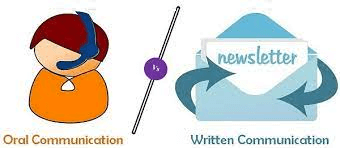Difference Between Oral and Written CommunicationCommunication is a fundamental aspect of human interaction that involves exchanging ideas, thoughts, and information between individuals or groups. It is an essential tool for conveying messages and conveying meaning, helping people to share their thoughts and feelings with others. Communication can take many different forms, including verbal, nonverbal, written, and visual, and it can occur in a wide range of contexts, such as personal, professional, social, and cultural settings. Verbal communication is the most common form of communication and involves the use of language to convey messages. This can occur through spoken words, such as in a conversation or speech, or through written words, such as in a letter or email. Verbal communication can be further divided into formal and informal communication, depending on the context in which it occurs. Nonverbal communication, on the other hand, involves conveying meaning without using words. This can include body language, such as gestures, facial expressions, and posture, as well as tone of voice and other vocal cues. Nonverbal communication is often used to convey emotions or attitudes and can be an important part of interpersonal communication. Written communication is another important form of communication that involves using written words to convey messages. This can include emails, letters, reports, and other written documents. Written communication is often used in professional and academic settings, but it can also be used in personal communication. Visual communication involves conveying information through visual elements, such as pictures, charts, graphs, and videos. It can be used to convey complex information in a more easily understandable way, and it is often used in educational and business contexts. 1. Oral CommunicationOral communication refers to the exchange of information, ideas, and feelings through spoken words. It is one of the most common and important forms of communication, and it plays a vital role in our personal and professional lives. Oral communication can take many forms, including conversations, speeches, presentations, and interviews, and it can occur in a wide range of contexts, such as social, educational, and business settings. Effective oral communication requires several key skills, including listening, speaking, and nonverbal communication. Listening involves actively paying attention to what the speaker is saying, processing the information being conveyed, and asking questions or seeking clarification when necessary. Speaking involves articulating ideas clearly and concisely, using appropriate tone, volume, and adapting the message to the needs of the audience. Nonverbal communication involves using body language, facial expressions, and other nonverbal cues to convey meaning and emotion. In business and professional settings, oral communication is essential for building relationships, negotiating agreements, and presenting information to clients and colleagues. Effective oral communication can help to build trust and credibility, demonstrate expertise, and persuade others to take action. It is also important for teamwork and collaboration, as it allows team members to share ideas, provide feedback, and make decisions together. 2. Written CommunicationWritten communication is the exchange of information, ideas, and thoughts through written words. It is a crucial form of communication that is used in various contexts, including personal, academic, professional, and social settings. Written communication can take many forms, including emails, memos, letters, reports, and social media posts. Effective written communication requires several key skills, including writing, editing, and formatting. Writing involves the ability to articulate ideas and thoughts in a clear and concise manner, while editing involves reviewing and refining written documents to improve their clarity, accuracy, and overall quality. Formatting involves organizing the written document in a way that is visually appealing and easy to read, such as using headings, bullet points, and paragraphs. Written communication is essential in academic and professional settings, where it is often used for research, reports, proposals, and other types of written documents. Effective written communication can help to demonstrate expertise, build credibility, and persuade others to take action. It is also crucial for collaboration and teamwork, as it allows team members to share information and ideas in a structured and organized way. In personal settings, written communication is often used for personal letters, emails, and social media posts. Written communication can help to maintain relationships, express emotions and thoughts, and keep in touch with friends and family who are far away. Difference between Oral and Written CommunicationOral and written communication are two primary forms of communication that are used in different contexts. Both of these forms of communication have their own characteristics, advantages, and disadvantages. The below-listed table summarizes the difference between Oral and Written Communication. 
Advantages of Oral Communication:
Disadvantages of Oral Communication:
Advantages of Written Communication:
Disadvantages of Written Communication:
SummaryIn conclusion, both oral and written communication have their own unique advantages and disadvantages. Oral communication is suitable for small groups and informal settings, is faster and provides immediate feedback, but may be less accurate and clear. Written communication is suitable for large groups and formal settings, is more accurate and clear, but maybe slower and provides delayed feedback. Choosing the right form of communication depends on the context, the audience, and the purpose of the message.
Next TopicDifference between
|
 For Videos Join Our Youtube Channel: Join Now
For Videos Join Our Youtube Channel: Join Now
Feedback
- Send your Feedback to [email protected]
Help Others, Please Share










